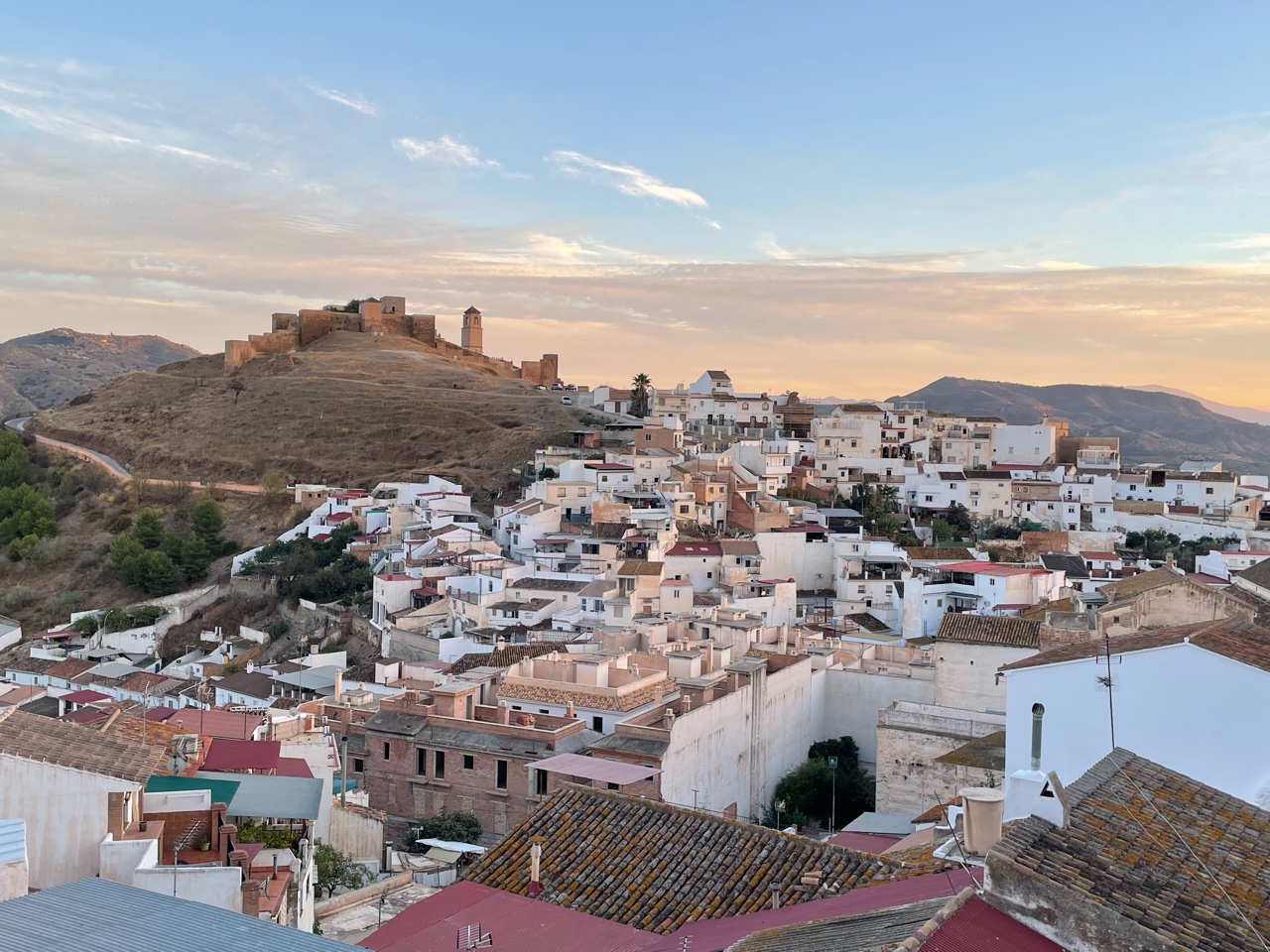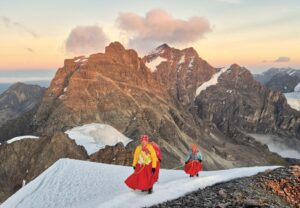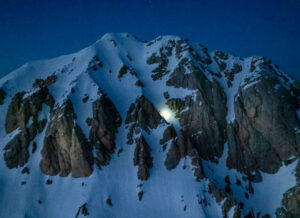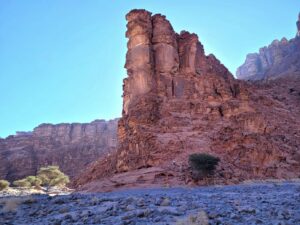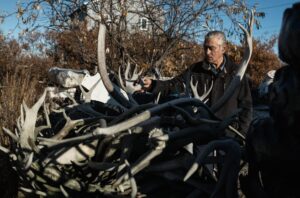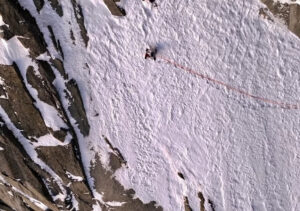Just 50km from the Mediterranean and the Andalusian city of Malaga lies El Chorro, a world-class climbing destination. In the 1980s, it was one of the first places in Europe to develop sport climbing routes. Since then, routes have multiplied, extending from the gorge and across the imposing Frontales cliffs that loom over the village.
Outside of El Chorro, the Andalusian landscape offers an abundance of limestone and cliffs. Some of these extraordinary crags, such as the higher ones of El Torcal, Turón, and Desplomilandia, are an easy day outing by car from El Chorro.
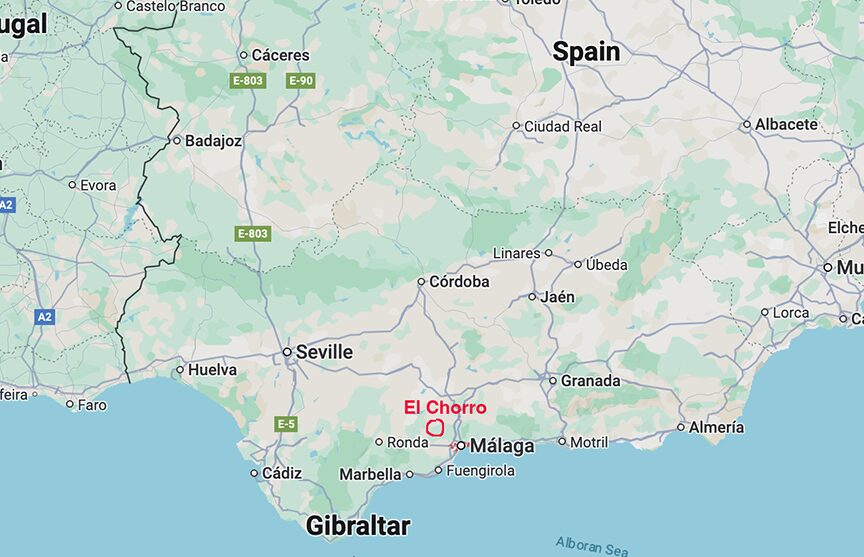
Single and multi-pitch routes range from extremely difficult, through a vast selection of superb medium-difficulty routes, to entire crags offering easier grades. In addition to the many single-pitch sport routes, a growing number of fully bolted routes up to ten pitches long cover the entire range of difficulty.
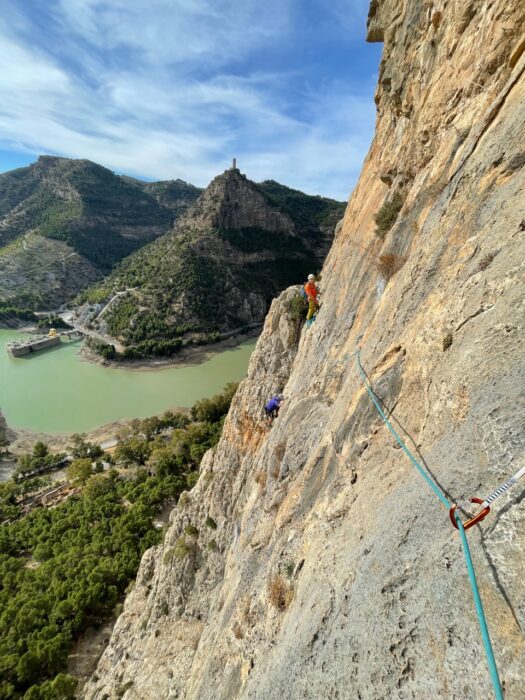
Climbing one of the multi-pitch routes in El Chorro. Photo: Monica Malfatti
El Caminito del Rey
In the El Chorro area, there is an old trail built between 1901 and 1905 to allow workers at the local hydroelectric plants to access the gorge for maintenance. In 1921, King Alfonso XIII visited to inaugurate a new dam and walk the gorge. From then on, the trail was called El Caminito del Rey, the king’s little path.
During the 1980s, the walkway offered a memorable way to reach the walls in the lower gorge, and climbers established some fantastic routes. However, the trail rapidly deteriorated and became dangerous. In 2000, the government removed the first section of the trail to prevent public access.
Yet climbers are difficult to keep away, and eventually, the government redeveloped the trail as a tourist attraction. Work began in 2014, and in March 2015, El Caminito del Rey reopened to the public.
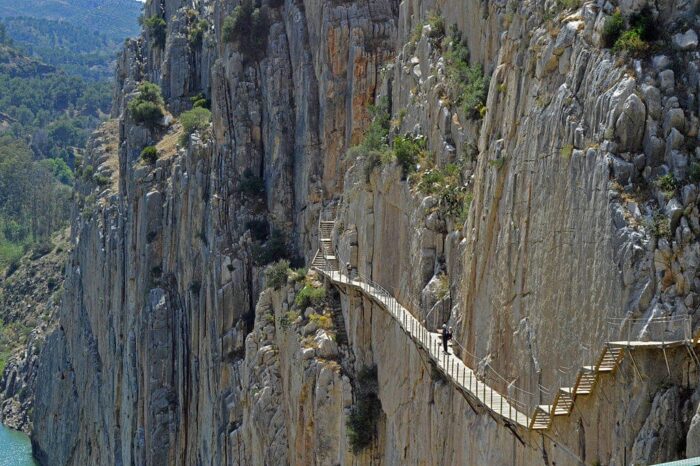
El Caminito del Rey. Photo: Spain.info
The situation now
The new walkway is an extraordinary feat and has become a major tourist attraction. The government permits access only from the gorge’s northern entrance and strictly limits the number of people, so booking on the official website is almost always essential.
For climbers, this means that it is no longer possible to access the climbing routes in the lower and upper gorges. Fortunately, the increase in available routes elsewhere in the area has more than offset the loss.
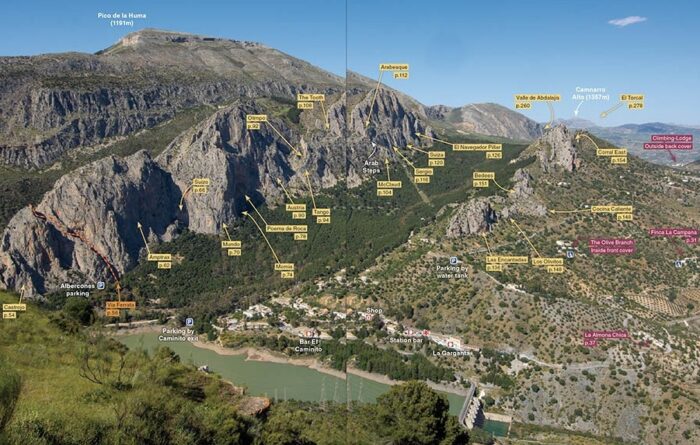
Map of El Chorro. Photo: Mark Glaister
Guide to the crags
- Frontales is a massive cliff above the village of El Chorro. With 231 routes of all grades, both single and multi-pitch, it caters to everyone.
- Escalera Arabe is one of El Chorro’s premier areas, perched high above the valley and packed with superb climbs. Among its 143 routes, there are plenty of lower grades.
- Serena is a small crag with 19 well-bolted pitches in the lower and mid-grades, with a stunning vista. It gets lots of sun, but can also pick up a breeze.
- Las Encantadas is a striking crag composed of blank-looking faces and offering exceptional wall climbing for all levels. It has 56 routes, and the access is almost roadside.
- Los Olivitos, Cocina Caliente, and Bedees are a trio of pleasant, easily accessed buttresses with plenty of routes in the lower and mid-grades. Good for a quick hit.
- Corral East is a reasonable crag with 16 worthwhile lines and one low-grade multi-pitch climb. A bit of a walk is necessary to get there.
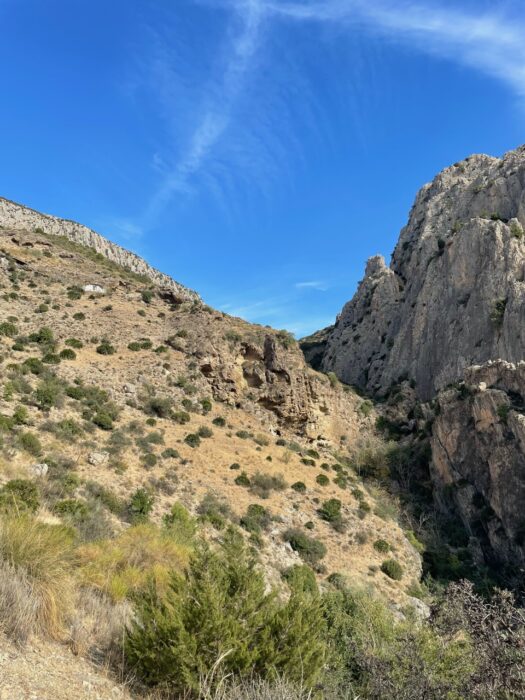
Heading to the crags. Photo: Monica Malfatti
- Rocabella is an unusual ridge of good rock that has lots of lower-grade climbs (26 routes in all). Access is pretty quick, and sun and shade are both available.
- Caliza is a roadside crag that is better than it looks. The rock is good, and its 25 routes are fairly popular. The crag is in the shade all day.
- Los Cotos is a remote set of extensive slabs. Little visited because of the long approach, the trek is worth it for some of its 66 routes.
- El Polvorin is a fantastic wall of vertical, lightly featured rock lined with tough 30m wall climbs in the VI. A long approach, but worth it. There are 18 routes.
- Makinodromo is one of Europe’s most famous cliffs, a mecca for Grade 8 climbers. Over the last decade, it has developed considerably, and it now has 155 routes.
- Desplomilandia is a popular venue with many outstanding single-pitch lines (183 in total). It is well-shaded and a good place when it gets too hot.
- Poza de la Mona is a long, shady crag not far from the road with 46 routes of all grades.
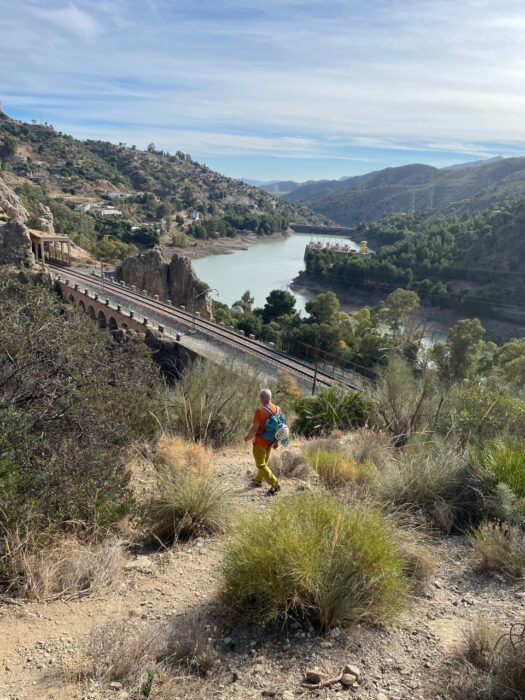
The way back down. Photo: Monica Malfatti
- Turón is a fantastic set of huge slabs in an enchanting environment. There are some harder vertical routes here, too.
- Valle de Abdalajis is a popular area close to El Chorro with near-vertical walls split by cracks of all sizes. There are 88 routes.
- El Torcal is a high plateau of heavily eroded limestone that is a good place to head in hot weather. The 72 routes are well bolted but not a pushover.
- Villanueva de Cauche is close to the road but quiet and packed with hard wall climbs. Enough routes, with 70 at Grade VI.
- Puerto Rico is an extensive crag of tufa rock in the hills inland from Marbella. A hot spot best reserved for cool weather, but with extremely fun climbing. A total of 78 routes.
- Mijas is a series of open faces with good views and a dank, shady ravine located in the tourist area of Mijas. With 104 routes, some like it and some hate it.
- Pinares de San Anton is a set of two faces high above Malaga. Lots of face climbing and few steeper sections. Sun or shade throughout the day on all 104 lines.
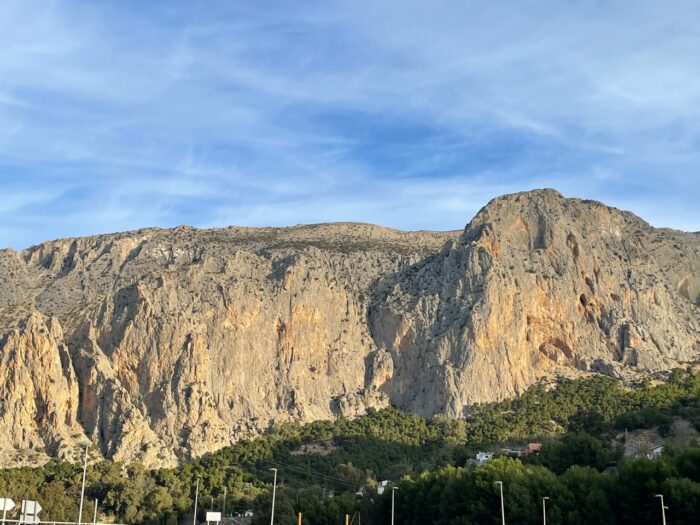
The walls from the main road. Photo: Monica Malfatti
Beyond climbing
The region not only offers climbing. Tourism has heavily developed the coastal strip, but the mountains inland are a stark contrast, dotted with typical Andalusian villages. These villages are excellent places to immerse yourself in the area’s laid-back culture and enjoy a meal in the many bars and restaurants. Conversely, the cities of Seville and Granada offer Spanish city life at its best. If you love art, don’t miss the Picasso Museum in Malaga.
Weather
The best climbing weather is usually between mid-October and early May. During this period, air temperatures can be perfect, with plenty of sun, shade, and/or altitude options. Winter months can be chilly, so a warm coat and hat are essential, but there are plenty of good sunny crags available.
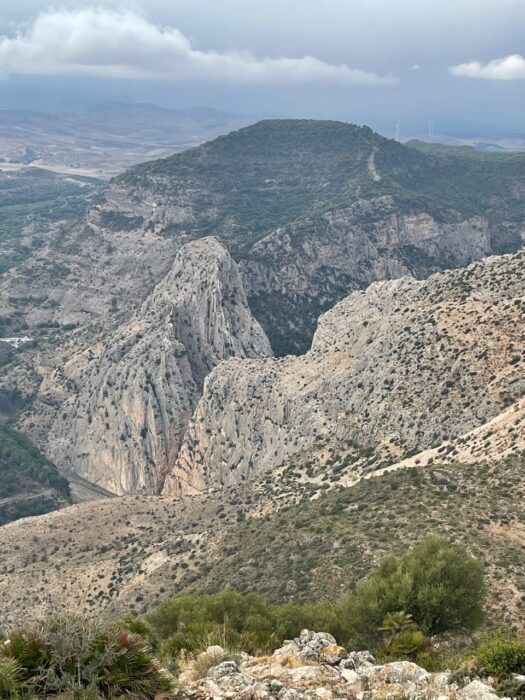
The view from the summit. Photo: Monica Malfatti
El Chorro is at its best in autumn and spring, yet it can get very hot even at this time of year. Don’t forget shorts, sunscreen, and a hat. Occasionally, it rains. It is best to avoid summer, from June to mid-September, as temperatures inland can reach 40°C. If you find yourself in a heat wave, the shade of Desplomilandia and the altitude of El Torcal may be cool enough.
How to get there
The closest major airport to El Chorro is Malaga International Airport. It is one of the best-served and busiest airports in Europe, with flights from all major European destinations year-round. Prices are also among the lowest available for any climbing destination in Spain.

The village of El Chorro. Photo: Monica Malfatti
Where to stay
El Chorro has several excellent lodge-style accommodations, fully equipped for the rock climbing market. An advantage for solo travelers is that there are always other climbers staying at these places, and many of the crags are within walking distance. I recommend: Climbing Lodge, The Olive Branch, and Finca La Campana.
There are many accommodation options available near El Chorro, from small cottage-style townhouses to enormous villas with pools. Many of these are within walking distance of the cliffs and the village of El Chorro, for those without a car.
The surrounding villages and towns also offer rental properties and will be of interest to those seeking a wider selection of shops, restaurants, and bars, such as those in the lively towns of Alora, Ardales, or the Abdalajís Valley. Accommodation is quite reasonable. I recommend Casa El Chorro, Cortijo Don Rodrigo, and La Almona Chica.
